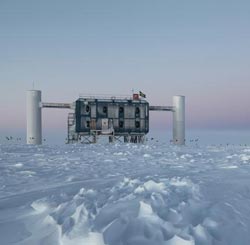Racing particles from space

<br>
For the first time scientists have uncovered concrete evidence for highly energetic neutrinos stemming from outside our solar system.
The IceCube experiment, a huge neutrino detector in Antarctica in which the Technische Universitaet Muenchen (TUM) is involved has observed 28 neutrinos that most likely stem from cosmic objects such as supernovae, black holes, pulsars or other extreme cosmic phenomena.
A wide variety of particles perpetually pound onto the Earth’s atmosphere. Most of these particles, like protons, electrons or helium nuclei have a certain mass and carry an electrical charge. When they collide with other particles or are deflected by the cosmic magnetic fields, the sun or the Earth, they alter their path and energy. Not so, the uncharged and extremely light neutrinos:
They speed right through all mater, more or less undisturbed. Every second billions of neutrinos pass through each square centimeter of the Earth’s surface. The vast majority of these elementary particles are created in decay and transformation processes within the sun or in the Earth’s atmosphere. Neutrinos that stem from outside our solar system, from the outer reaches of our galaxy or even further away, are much rarer.
These astrophysical neutrinos are highly interesting for physicists. They offer clues to the powerful cosmic objects they stem from: supernovas, black holes, pulsars, active galactic cores and other extreme extragalactic phenomena. Now the scientists of the IceCube experiment, which includes researchers from the Cluster of Excellence Universe at the TUM, report they have observed, for the first time, high-energy neutrinos.
The 28 events were recorded between May 2010 and May 2012. Each of these neutrinos had an energy of over 50 tera-electron volts (TeV). That is a thousand fold more energy than any neutrino from a terrestrial accelerator has ever reached. “These are the first indications of neutrinos from outside our solar system,” says TUM physicist Professor Elisa Resconi, who is a member of the IceCube collaboration.
“These events can be explained neither by causes like atmospheric neutrinos, nor by other highenergy events like muons created in the Earth’s atmosphere during interactions with cosmic rays.”
After observing hundreds of thousands of atmospheric neutrinos, the researchers are finally convinced they have proven the existence of neutrinos that fulfill their expectations of astrophysical neutrinos that in all likelihood stem from cosmic accelerators. “Now we must determine where these neutrinos come from and how they are created. We are at the frontier of a new astronomy with neutrinos,” says Elisa Resconi.
The IceCube observatory is melted into the permafrost of the South Pole, an installation that was completed in 2010 following seven years of construction. At one cubic kilometer in size, it is the largest neutrino detector worldwide. 86 vertical wire ropes with a total of 5160 optical sensors were sunk 1450 to 2450 meters into the ice. IceCube detects neutrinos via tiny flashes of blue light, so called-Cherenkov radiation, which appears when neutrinos interact with ice, generating a shower of charged particles.
The observatory is run by an international consortium under the direction of the University of Wisconsin, Madison (USA). The research team comprises some 250 scientists and engineers from USA, Germany, Sweden, Switzerland, Japan and other countries.
Publication:
Evidence for High-Energy Extraterrestrial Neutrinos at the IceCube Detector, IceCube Collaboration, Science, 22. Nov. 2013 – DOI:
Contact:
Prof. Dr. Elisa Resconi
Technische Universitaet Muenchen
Experimental Physics of Cosmic Particles
Cluster of Excellence Origin and Structure of the Universe
Boltzmannstr. 2, 85748 Garching, Germany
Tel.: +49 89 35831 7120 – E-mail: elisa.resconi@tum.de
Technische Universität München (TUM) is one of Europe’s leading universities. It has roughly 500 professors, 10,000 academic and non-academic staff, and 35,000 students. It focuses on the engineering sciences, natural sciences, life sciences, medicine, and economic sciences. After winning numerous awards, it was selected as an “Excellence University” in 2006 and 2012 by the Science Council (Wissenschaftsrat) and the German Research Foundation (DFG). In both international and national rankings, TUM is rated as one of Germany’s top universities and is dedicated to the ideal of a top-level research-oriented entrepreneurial university. The university's global presence includes offices in Beijing (China), Brussels (Belgium), Cairo (Egypt), Mumbai (India) and São Paulo (Brazil). The German Institute of Science and Technology (GIST – TUM Asia), founded in 2002 in Singapore, is the first research campus of a German university abroad.
Media Contact
More Information:
http://www.tum.deAll latest news from the category: Physics and Astronomy
This area deals with the fundamental laws and building blocks of nature and how they interact, the properties and the behavior of matter, and research into space and time and their structures.
innovations-report provides in-depth reports and articles on subjects such as astrophysics, laser technologies, nuclear, quantum, particle and solid-state physics, nanotechnologies, planetary research and findings (Mars, Venus) and developments related to the Hubble Telescope.
Newest articles

Superradiant atoms could push the boundaries of how precisely time can be measured
Superradiant atoms can help us measure time more precisely than ever. In a new study, researchers from the University of Copenhagen present a new method for measuring the time interval,…

Ion thermoelectric conversion devices for near room temperature
The electrode sheet of the thermoelectric device consists of ionic hydrogel, which is sandwiched between the electrodes to form, and the Prussian blue on the electrode undergoes a redox reaction…

Zap Energy achieves 37-million-degree temperatures in a compact device
New publication reports record electron temperatures for a small-scale, sheared-flow-stabilized Z-pinch fusion device. In the nine decades since humans first produced fusion reactions, only a few fusion technologies have demonstrated…





















